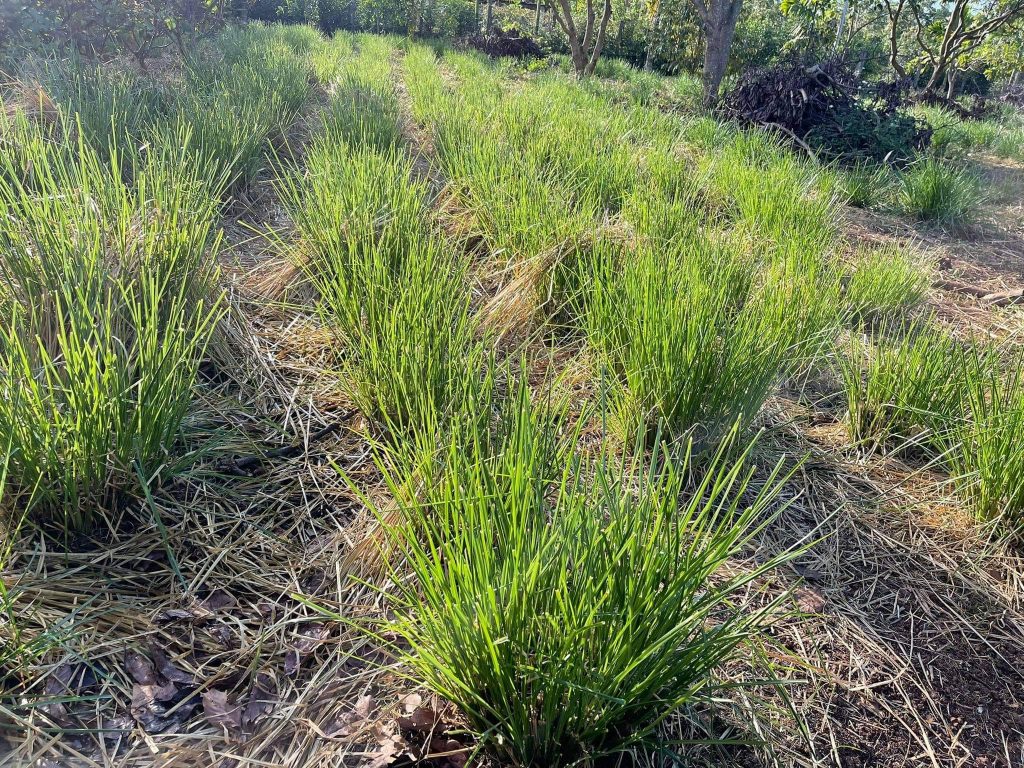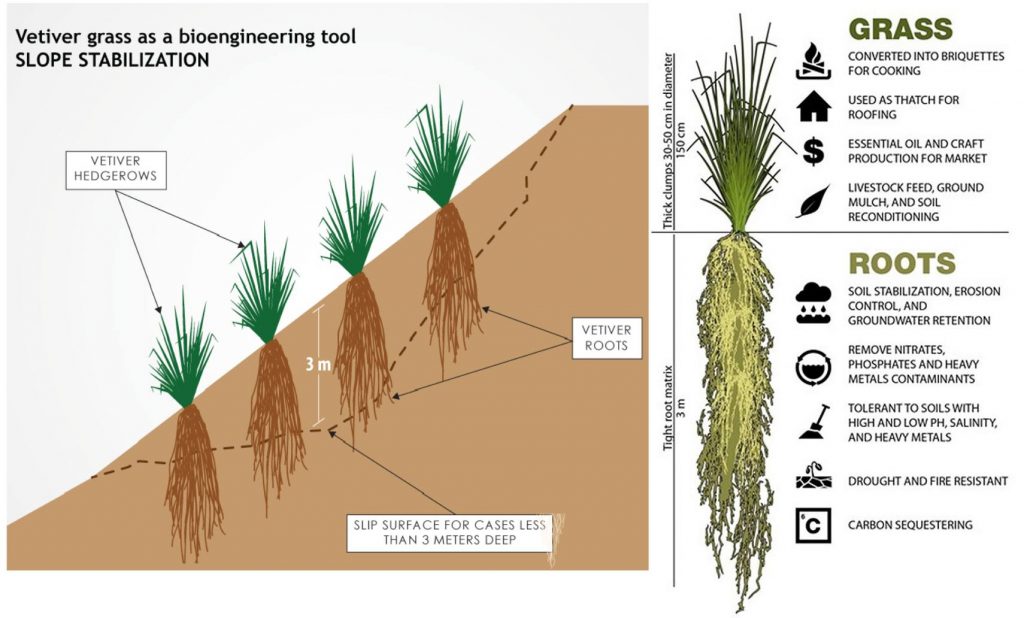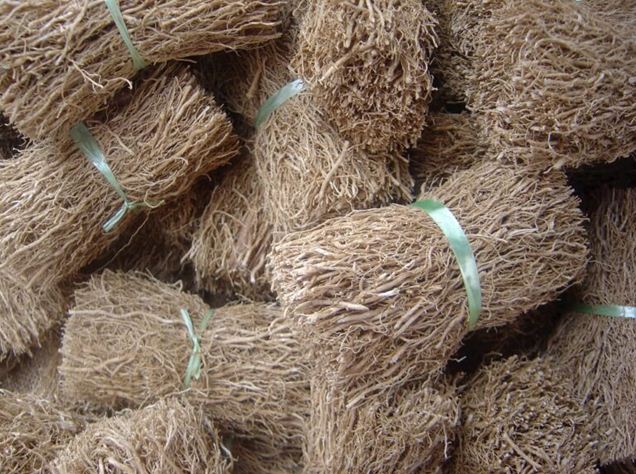Good for landside control and many others
 The Nepal Weekly
The Nepal Weekly  January 24, 2023
January 24, 2023
Vetiver is a type of grass, native to tropical Asia and has been introduced into the tropics of both hemispheres; it has escaped cultivation and become a weed in some regions. This is a perennial grass of the family Poaceae which is also called Khus and Khaskhas in Nepal. It is called “Usheera” in Ayurvedic texts.
Vetiver is a large tufted bunchgrass and can reach up to 1.5 metres (5 feet) in height. The thin leaves and stems are erect and rigid, and the plant bears small brown-purple flowers in long spikes. The fragrant roots grow downward in the soil and can attain depths of more than 3 metres (10 feet). From the roots, the leaves spread in clumps (culm) and they are 2 m. tall and upright. Its rhizomes and fine roots become fragrant when dried. In the month of August, this grass flowers and bears fruit.
Vetiver grass is found in the tropical and sub-tropical regions of Nepal at 200 m – 1,200 m altitude. It grows in open grasslands and frozen areas. It is found in Nepalgunj (Banke district) in the west and Koshi Tappu (Sunsari district) in the east. The plant is sometimes grown as a hedge and is useful in dryland restoration to reduce soil erosion. Moreover, the plant is very drought-resistant.
Experts and campaigners who are engaged in multiple utilisation of vetiver mention that vetiver is a multi-benefit plant. A revolutionary agricultural product which is just a “Grass” but that has the potential to build the nation in a substantial measure as it reaches an array of benefits from the point of view -environmental, economic and social.It can contribute human beings by serving as an unparalleled poverty alleviation measure to conserving precious soil and water; from reclaiming wastelands as more than half a million hectares of wastelands could be transformed into fertile farms to provide nutrient-rich mulch to the plants and soil.So as saving the agricultural crops like rice, maize and the rest from pests like Stem Borer and others to sequestering carbon and injecting nitrogen through bacteria in the soil to providing protein-rich feed to cattle. It is also a bio-engineering solution against floods from the devastating rivers and from landslides in fragile hills to stabilizing landfills, leachate and mines by removing metallic contaminants through phytoremediation.

Vetiver also help cleaning polluted rivers from disposed wastes to stabilizing the polluted wastes generated by manufacturing activity. Likewise, it is also useful for one of the most critical bases for medicines to a premium intermediate for perfumery that fetches a substantial value which stand at around NPR 25,000 kg. That means farmers can generate NPR 400,000 to 500,000 in a year from vetivar which stand better than other crops like rice, maize or wheat.
In addition, vetiver is a highly suited option for our holistic empowering. It also helps other crops to cohabit with it providing larger collective yield vis-a-vis monoculture farming.
Vetiver being added to the land volume in use on one hand and will also have multi-layer farming on the concept of permaculture to further add land mass in use. If implemented sincerely, it has the potential to transform our socio-economic and ecological landscape in a large measure.
The hitherto lying wastelands and the abandoned land mass put together, it can be claimed that vetiver can contribute help provide security to the nation in the all-important arena of food, energy, climate, sustainable agriculture, disaster mitigation, sustenance of agro-based manufacturing, import-substitution and substantial revenue from exports of high value products, employment, including herbs at a fraction of the costs. Vetiver is known to be among the highest carbon sequestering species from shoot as well as roots. Along with substituting fossil fuel, most of the BioEnergy processes help produce organic fertilizer as a by-product. Not only the current requirement of fertilizer in the country could be met with the output, but also there could be a huge surplus for exports too. Also, very importantly the ‘waste-to-wealth’ and ‘waste-to-energy’ phenomena will find due vindication. Similarly, firewood uses for domestic fuel may be substituted by renewable and green options of biogas and bio-briquettes made using vetiver as the energy value of vetiver shoot is almost 175% of bagasse and rice husk. So as such briquettes may replace use of coal in industrial furnaces.
Moreover, experts say that vetiver can contribute to (a) Food Security – about 4 to 5 million tons of paddy and other foodgrains annually to grow more than usual; (b) Employment opportunity – about 2 to 2.5 million organised sector jobs with total unused lands put into use along with multi-layer farming; (c) Energy Security – total substitution of fossil fuels (diesel, petrol, LPG etc.) valuing 2.5 to 3 trillion rupees with green, renewable fuel produced from biomass either through the Biogas-CNG route or through other Bio-energy measures including bio-ethanol, biomass to electricity etc. This will help neutralize more than country’s carbon emission of 8 million tons and help render us carbon negative, which in turn would entitle the country to a much larger and respectful facilitation from global development organizations. It can also be added as one more product for carbon trade.

Vetiver Nepal is a non-government organization thathas been engaged in conducting research on vetiver-grass and raising awareness to all stakeholders on the benefits and characteristics of vetiver in Nepal. (RP Narayan)

